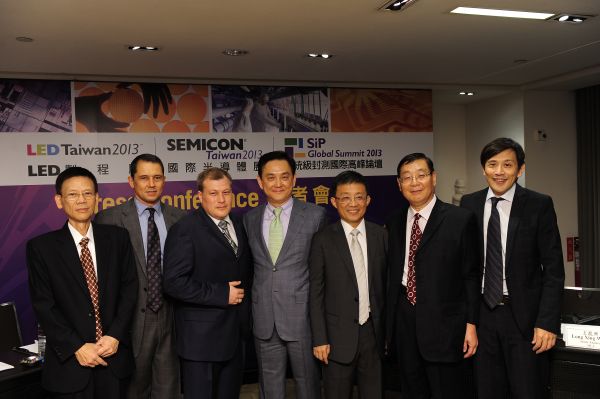SEMICON Taiwan Semiconductor exhibition and LED Taiwan held a press conference yesterday before the exhibition officially launched on September 4th. SEMICON expressed that global semiconductor growth is stable and capital for 2013 is expected to be similar to that of 2012, with hopes that capital in 2014 will return to NT $44 Billion.
 |
|
AT SEMICON Taiwan Semiconductor and LED Taiwan's press conference yesterday, experts discussed the future trend for the LED industry. |
According to SEMI Opto/LED wafer production quarterly predictions for HB-LED FEOL wafer manufacturers, after a drop in LED wafer manufacturing equipment expenses in 2011 and 2013 of 45 percent and 30 percent respectively, 2014 is expected to see an increase of 17 percent reaching close to NT$1.2 billion. The increase is due to the LED industry’s aggressive attempt to curb the surplus problem. 2014 is also expected to have a restoration in capital and a widening of production capacity. This is similar to predictions by LEDinsid towards MOCVD and other related processing equipment. LEDinside originally forecasted that some 2013 MOCVD equipment orders would be deferred to 2014. Therefore much like 2013, 2014 will also experience growth.
The equipment expense trend within the LED industry shows that current expenses mainly focus on big named manufacturers and ambitious companies rather than up and coming manufactures or emerging technologies.
It was expressed during the conference that global LED industries are all stabilized. Most large LED manufacturers have invested in purchasing 6-inch wafer production systems and other related equipment which provides even higher production capacity. Manufacturers who have made the switch to 6-inch wafers include Cree, Philips Lumileds, and OSRAM. Nichia also continues to invest in advancing production capacity and technology.
Taiwan Epistar, Formosa Epitaxy and Genesis Photonics are all predicted to invest heavily in manufacturing during 2013. Big named manufactures are all modernizing their production systems, increasing investment in fields like automation, engraving, measuring, and lithography.
Chinese government subsidies are slowly decreasing. SEMI still believes that in 2014 China will revert back to buying MOCVDs. According to SEMI’s predictions, purchase of MOCVD reactors in 2014 will increase to almost 50 percent, surpassing 2013 purchases of around 150 reactors. SEMI also believes that due to market consolidation and strong competitors disappearing, many China LED wafer manufactures closed down or changed direction of production.
The focus of the market is on production capacity for big named Chinese wafer manufacturers. San’an has over 120 MOCVD machines and ETi has around 90 machines, both are currently continuing to increase wafer production capacity rate and are expected to becoming important emerging industries. Equipment expenditures in China for 2014 is expected to be 44 percent which surpasses 33 percent for 2013.












